Pump Handbook by Igor J. Karassik, Joseph P. Messina, Paul Cooper, Charles C. Heald - 3rd edition
Подождите немного. Документ загружается.

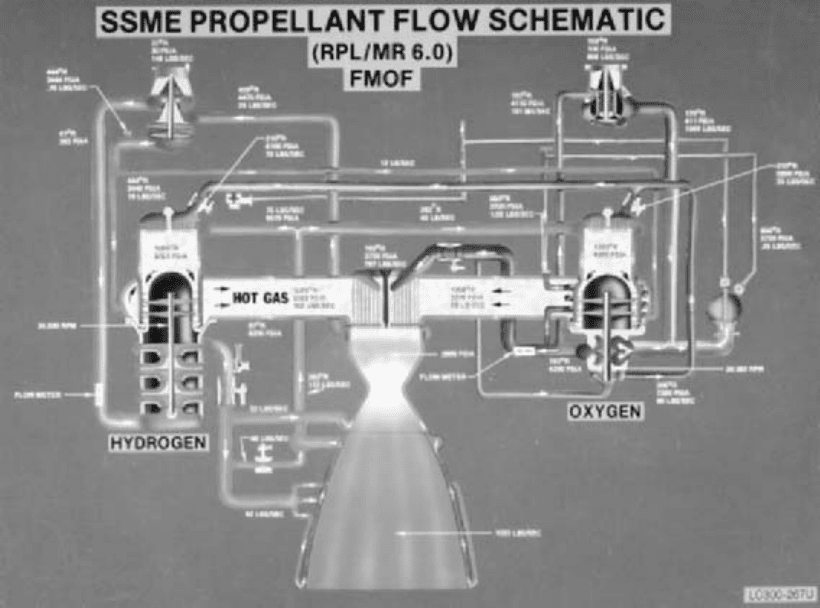
9.436
FIGURE 3 SSME liquid oxygen and hydrogen pumping arrangement (Courtesy of
The Boeing company)
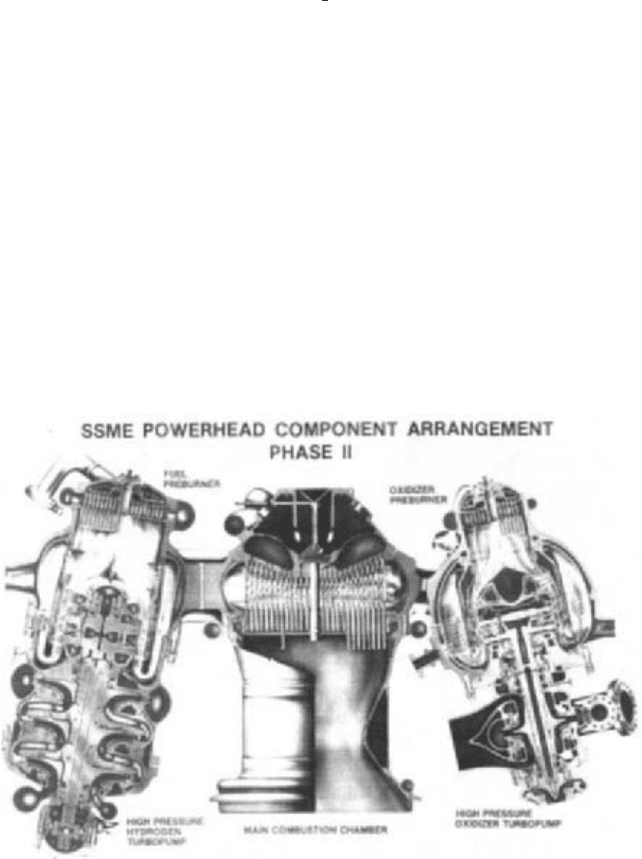
9.19.2 LIQUID ROCKET PROPELLANT PUMPS 9.437
loss due to cavitation at all engine conditions. Specific speed N
s
3,230 (1.18), which
is low for an inducer, but this one performs a more substantial pumping task than do
inducers running at high speeds on the same shaft as the high-pressure centrifugal
stages they feed. The shaft has two ball bearings cooled by liquid oxygen, and the
envelope of the package is 18 in (457 mm) in diameter 18 in (457 mm) long.
• The low-pressure fuel turbopump (LPFTP) is similar in concept to the LPOTP. It is a
2,900 hp (2.2 MW) machine that runs at 15,700 rpm. The inducer-type impeller is
12.014 in (305 mm) in diameter and is driven by a two-stage gaseous-hydrogen turbine.
It ingests liquid hydrogen to the extent of of the mass flow rate of oxygen. Due to the
very low specific gravity of liquid hydrogen (= 0.0708 at atmospheric pressure), the head
rise is more than 7,000 ft (2,100 m). N
s
2,550 (
s
0.93). The shaft has three ball
bearings cooled by liquid hydrogen, and three seals limit leakage between the pump and
the turbine before engine start and during operation.
• Both low-pressure pumps exhibited suction-specific speeds N
ss
in excess of 35,000 (
ss
13)
4
.
They are shown schematically at the top of Figure 3, and the high-pressure pumps are
below them.
• The high-pressure oxygen turbopump (HPOTP) is shown in cross-section in Figure 4
together with the associated preburner unit. Inducers are shown in the detailed cross-
sectional drawing of Figure 5 feeding the double-suction main stage that generates nearly
5,000 lb/in
2
(34 MPa)
—
making this one of the world’s highest-energy pumps (as defined
in Section 2.1, Figure 32).And more than 3,000 lb/in
2
(21 MPa) in addition to this pressure
is generated in the small booster impeller (on the outer end of the turbopump as seen in
Figures 4 and 5) that feeds about 11 percent of the main flow to the preburners for driving
both high-pressure pumps. Both shrouds of the main impeller act as orificed balancing
disks to keep all but a small preload off the two angular-contact ball bearings, which are
cooled by liquid oxygen. Radial loads are minimized by the use of a vaned diffuser. The
compact design and high speed (over 31,000 rpm) of this 28,000 hp (21 MW) machine
result in operation between the first and second critical speeds. Several seals are utilized,
1
6
FIGURE 4 SSME high-pressure turbopumps (Courtesy of The Boeing company)
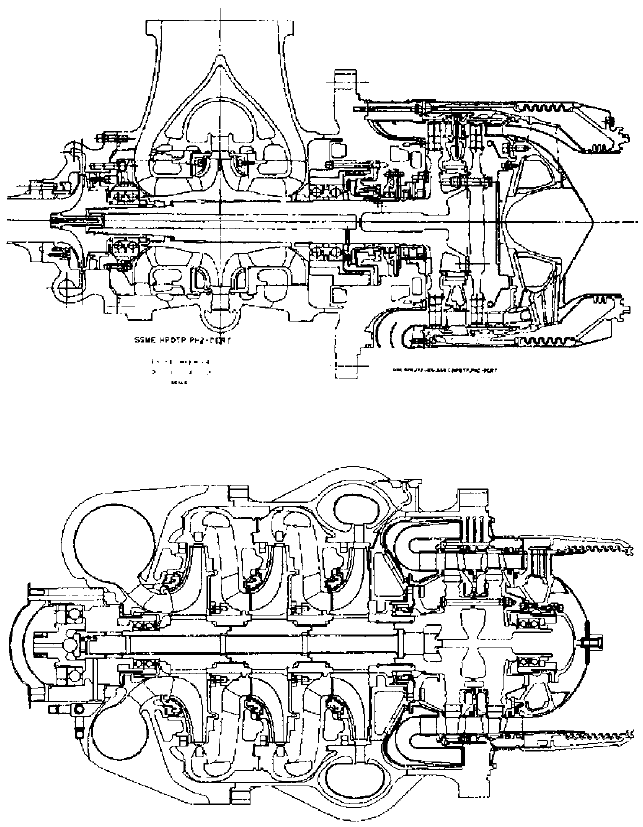
9.438 CHAPTER NINE
FIGURE 5 Cross-section of SSME high-pressure oxygen turbopump (Courtesy of The Boeing company)
FIGURE 6 Cross-section of SSME high-pressure oxygen turbopump (Courtesy of The Boeing company)
including a helium-purged seal that isolates the hot gas of the turbine from the cold liq-
uid oxygen. Special material combinations are used to prevent sparking, ignition and
explosion due to rubbing in the strong oxidizing environment of the liquid oxygen.
• The high-pressure fuel turbopump (HPFTP) is also shown in Figure 4. Additional detail
is afforded by the cross-sectional drawing of Figure 6. No inducer is needed due to the
pressurization of the LPFTP and the more favorable vaporization characteristics of liq-
uid hydrogen. The pump has three identical impellers and diffusers, except that the
third-stage diffuser discharges into a scroll or volute, and the third-stage impeller also
9.19.2 LIQUID ROCKET PROPELLANT PUMPS 9.439
acts as an orificed balancing disk, which removes all axial thrust (except for a small
spring-preload force) from the angular-contact, liquid hydrogen-cooled ball bearings
located at each end of the pump-and-turbine package.The head per stage is over 65,000
ft (20,000 m) because of the high pressure rise and low density of liquid hydrogen. This
leads to an impeller OD tip speed of nearly 2,000 ft/sec (600 m/s)
—
probably the highest
in existence for a pump and successfully deployed in titanium, which has the benefit of
a higher strength-to-weight ratio than the more commonly used steels. The high speed
(over 37,000 rpm) keeps this 77,000 hp (57 MW) machine small and light and necessi-
tates operation between the second and third critical speed.
THE RD-170 ENGINE__________________________________________________
The RD-170 rocket engine was developed in the Soviet Union and is described in some
detail by Sutton
6
. Propellants are liquid oxygen and an RP1 equivalent. Consisting of four
nozzles, each of which produces about the same thrust as one SSME, this “four-engines-in-
one” configuration is fed by a single propellant pump assembly
—
similar in concept to the
F-1 turbopump. Referring to Table 13 of Section 2.1, the oxygen pump produces a pressure
rise of about 8,500 lb/in
2
(59 MPa), which is undoubtedly the highest pressure rise of any
centrifugal pump stage in the world, making it the highest-energy pump of Figure 32 in
Section 2.1. Not far behind is the RP1 pump at 7,100 lb/in
2
(49 MPa). Assuming the pump
efficiency to be 80 percent would yield a total shaft power for both pumps of about 230,000
hp (172 MW). At such high energy levels, as discussed in Section 2.1, the life of this pump
must indeed be quite short. However, the design appears to have been successful. The only
drawback is the environmental issue concerning the burning of a large quantity of hydro-
carbon fuel, which is also an inhibition to further use of the F-1 engine.
REFERENCES _______________________________________________________
1. “Liquid Rocket Engine Centrifugal Flow Turbopumps.” Report SP-8109 of the series
entitled NASA Space Vehicle Design Criteria (Chemical Propulsion). NASA, 1973.
2. “Turbopump Systems for Liquid Rocket Engines.” Report SP-8107 of the series enti-
tled NASA Space Vehicle Design Criteria (Chemical Propulsion). NASA, 1975.
3. Furst, R. B. “Space Shuttle Main Engine Turbopump Design.” Society of Automotive
Engineers, Paper No. 730926, October 1973.
4. Furst, R. B.“Space Shuttle Main Engine Turbopump Design and Development.”Amer-
ican Institute of Aeronautics and Astronautics, Paper No. 75-1301, September 1975.
5. “Space Shuttle Technical Manual: SSME Description and Operation, Space Shuttle
Main Engine.” Report E41000/RSS-8559-1-1-1, published for NASA under Contract
NAS8-27980, The Boeing Company, Rocketdyne Propulsion and Power, July 1977.
6. Sutton, G. P. Rocket Propulsion Elements, 6th edition, Wiley, 1992.

P. A. NOLTE
9.441
SECTION 9.20
PORTABLE TRANSFER OF
HAZARDOUS LIQUIDS
Transfer systems for hazardous chemicals must not only take into account the best means
to transport the chemical based on the chemicals fluid characteristics, but must also pay
particular attention to both safety and environmental issues. The chemical can be some-
thing as common as gasoline, or a very poisonous restricted-use pesticide such as Para-
quat. When the requirement of portability is added to the chemical handling system,
design parameters must now take into account variables such as power source, environ-
mental conditions, and chemical restraints. Several power sources have been incorporated
through out the years for the portable transferring of hazardous chemicals. One of the ear-
liest is simple hand power. Others consist of gasoline powered, ground-driven, compressed
air, and battery operated pumping systems.
Major markets that require the portable transfer of chemicals include petroleum, agri-
cultural, construction, pest control, and lawn care. Systems must be adaptable to chang-
ing environmental regulations, chemical container designs, and application requirements.
AGRICULTURAL REQUIREMENTS ______________________________________
The need for portable chemical transfer systems in the agricultural market arises from
farmers working fields with large equipment, usually several miles away from local chem-
ical dealerships and storage facilities. It is usually more economical to bring the chemical
to the piece of application equipment while it is in the field, rather than transporting the
application equipment back and forth from the field. Chemical is delivered to the field in
several different ways, depending on the volume required. Tanks can vary in size from 120
gallon (450 liter) herbicide tanks that can be transported by pickup trucks, to large 1000
gallon (3800 liter) tanks that are delivered by trailers or large custom trucks. With the
growth of the custom applicator business, the sophisticated chemical transfer rigs have
9.442 CHAPTER NINE
focused on speed of transfer, flexibility to supply the chemical required, and the ability to
cover large areas. Some large aerial applicator rigs have the ability to allow spray heli-
copters to land directly on the rig, thus allowing quick, portable, and convenient transfer
of spray solution from tanks into the helicopter.
The majority of hazardous chemical transferring in the agricultural market deals with
the usage of either fertilizers or pesticides.A pesticide is a group of chemicals that consist
of insecticides, herbicides, or fungicides. Insecticides focus on the control of insects, herbi-
cides are chemicals used to control of grasses and weeds, and fungicides are chemicals
used to control crop damaging bacteria and/or fungus. During the last 20 years, the usage
of chemicals in the agricultural market has been greatly affected by growing environ-
mental concerns and worker safety. Environmental concerns have caused chemical for-
mulations to use less aromatic solvents. As an alternative, many chemicals are now
viscous water-based suspensions that generate pumping challenges. Chemical systems
have also seen new regulations that control items such as chemical spillage from fittings,
tank sizes, and design and testing parameters. This, in turn, has affected the needs and
requirements of the chemical handling systems.
Fertilizers present a transferring challenge due to the large volumes that are used, and
the corrosive nature of most solutions. Two types of power modes are commonly used in
the market for the transferring of fertilizers: gasoline-powered centrifugal pumps and
ground-driven positive displacement pumps. Gasoline-powered centrifugal pumps used
are usually lightweight aluminum or plastic units with 2 in (50 mm) ports.The pumps are
coupled to a 3 to 5 hp (2 to 4 kW) gasoline engine and are capable of transferring rates up
to 150 gpm (568 l/min). These high flowrate gasoline powered pumps are used to transfer
fertilizer and water from large 1000 to 2000 gallon (3785 to 7570 liter) transport tanks into
the application equipment’s on-board storage tanks, 300 to 500 gallons (1135 to 1890
liters) in size. Ground driven pumps are mounted on the implement equipment such as
planters and cultivators. The pumps are used to transfer and meter the fertilizer through
a network of tubing that runs to the backside of cutting blades. This allows the knifing of
the fertilizer into the ground. Ground driven pumps are popular for this type of applica-
tion because the volume dispensed is directly proportional to the ground speed of the
implement. Popular pumps that have been adapted for ground driven applications are pos-
itive displacement piston, diaphragm or multi-tube peristaltic pumps.
Pesticide transfer is now rigorously regulated because of environmental concerns and
an increased emphasis on decreasing worker exposure to the hazardous formulation of a
large percentage of these chemicals. The Environmental Protection Agency (EPA) has
guided the agricultural chemical industry away from using 2.5 gallon (9.5 liter) throw-
away containers to larger, returnable, re-usable, chemical-specific containers. These “Mini
Bulk” tanks range in size from 15 to 200 gallons (50 to 750 liters), depending on the chem-
ical usage rate. This change in the way farm chemicals are packaged to the end user has
generated new requirements for portable pumps. Current chemical delivery systems have
evolved around the usage of 12-volt power systems. Due to regulator restrictions that for-
bid the cross contamination of agricultural chemicals, the delivery systems are usually
designed for a particular chemical or container. An adequate pumping rate for most 12-volt
portable system is a rate of 5 to 10 gpm (18 to 38 l/min). Agricultural chemicals come in a
wide range of viscosities, varying from 1 to 500 centipoise. Some are true liquids, whereas
most are a suspension or mix. Typically, positive displacement pumps of the diaphragm,
piston, or gear type are used for portable chemical transferring. Gear pumps are usual lim-
ited to the low viscosity chemicals with no suspended solids. Piston and diaphragm pumps
are best suited to handle the higher viscous chemicals, many of which have suspended
solids. Chemicals with solids usually will require tank circulation, and this must be
designed into the transfer system.
Figure 1 shows a pumping system on a 120 gallon (450 liter) tank that consists of a
pump, 12-volt motor, a digital meter system, and no-drip hose coupling. The pump is per-
manently mounted to the shipping container at the time of tank manufacture. The motor,
meter, and hose are removable items that are normally supplied by the chemical dealer.
This allows the drive unit and metering device to be transferred from tank to tank, after
a tank is emptied. The pump is a 6-chambered plastic diaphragm pump and is mounted to
the tank by means of a bolting flange.The mounting flange also contains a built-in vent to
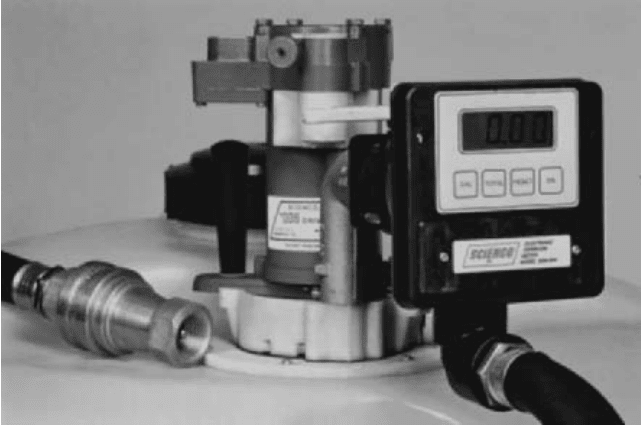
9.20 PORTABLE TRANSFER OF HAZARDOUS LIQUIDS 9.443
FIGURE 1 Portable 12-volt chemical pump (Flowserve Corporation)
allow air in during fluid pumping. An internal bypass valve in the pump is connected to
the inside of the chemical tank, allowing chemical circulation within the tank during
bypassing.This pump also allows manual opening of the bypass valve to allow drainage of
chemical from the meter and hose before removal. When the pump is mounted to the tank
during shipping, the complete system must meet and pass specific Department of Trans-
portation (DOT) tests. These tests are specified in the United States by DOT’s HM181
specifications. Depending on the size of the container and the hazardousness of the chem-
ical, these tests can require drop tests of several feet at 0°F (minus 17.8°C), vibration,
stacking, and pressure tests.
Figure 2 shows a typical 120 gallon (450 liter) chemical “Mini-Bulk” tank with the
pump connected to the tank by a coupler (not permanently attached). The coupler system
provides a means for attaching and detaching the pump and the tank, a means for vent-
ing, and a dip tube assembly allowing suction from the bottom of the tank. The pump
assembly is coupled through the tank coupling for chemical dispensing and is then
removed for transporting. The pump shown is a stainless steel, 12-volt diaphragm pump,
with a stainless steel flow meter. The chemical dealer fills the mini-bulk tank with chem-
ical. The grower purchases the chemical, uses the pump to dispense chemical into an appli-
cation rig, and then returns the tank empty to the dealer.
PETROLEUM AND CONSTRUCTION REQUIREMENTS______________________
One of the original areas requiring the use of portable pumps is the transfer of gasoline
and diesel fuel. The need to refuel and maintain equipment in remote locations has gen-
erated a large need for portable transfer equipment. Road and building construction, min-
ing, and farming all involve heavy equipment that must be refueled and maintained on a
regular schedule. One of the earliest and simplest methods of portable transferring was
with hand pumps. Hand pumps are positive displacement pumps of piston, vane, or
diaphragm-type design. Of course, the power supply is very limited with hand pumps, and
they are typically used only on thin liquids and small jobs. On large pieces of equipment,
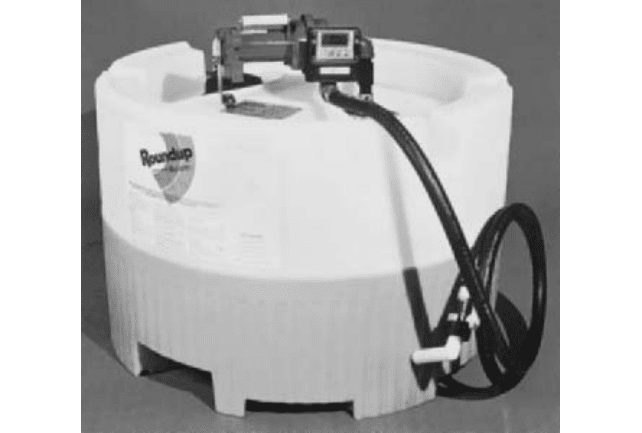
9.444 CHAPTER NINE
FIGURE 2 120 gallon (454 l) “Mini-Bulk” Container and pump (Flowserve Corporation)
the need is to transfer large volumes of fluids, such as water, antifreeze, diesel, gear lube,
grease, and transmission fluid.
Figure 3 shows a portable maintenance vehicle with air powered piston pumps. In the
construction industry, compressed air is a common power source for transferring product.
A typical truck consists of a gasoline-powered air compressor, several tanks of petroleum
products plus water and antifreeze. The size and type of pump will normally depend on the
size of the equipment requiring servicing and the fluid being pumped. For thin fluids, such
as diesel oil or gasoline, high volume, low pressure ratio pumps (approaching 1:1) will be
used. Occasionally, on units that have the option of a power take-off (PTO), a high volume
centrifugal-type pump will be used. For the oils and lubricants, higher pressure ratio
pumps (3:1 to 5:1) are required because of higher transfer pressure requirements. To
transfer grease, high pressure ratio pumps
—
to 20:1
—
are required. The pumps are nor-
mally coupled with a hose reel, 50ft (15 m) of hose, and a control nozzle.
LAWN AND PEST CONTROL ___________________________________________
Lawn and pest control companies require a portable means of transferring chemicals in
order to provide treatments. Liquids are used to treat yard infestations; in addition, the
majority of homes and buildings are treated for termites during construction. It is common
for lawn care companies to use PTO-driven centrifugal pumps capable of delivering 10 to
15 gpm (38 to 56 l/min) through a 100 ft (30 m) hose. Specialty requirements, such as tree
spraying, will require a higher pressure system, normally a gasoline-powered piston
pump. For insecticide treatment, the power source is commonly either electricity or gaso-
line. Typical pumps are roller pumps, capable of approximately 4 gpm (15 l/min) at 50
lb/in
2
(3.45 bar).
These industries have taken major steps to limit chemical exposure to the general pub-
lic and to their operators. Efforts have been made by many to eliminate the need of trans-
porting large 100-plus gallon (378 liter) tanks of mixed chemicals. One method that allows
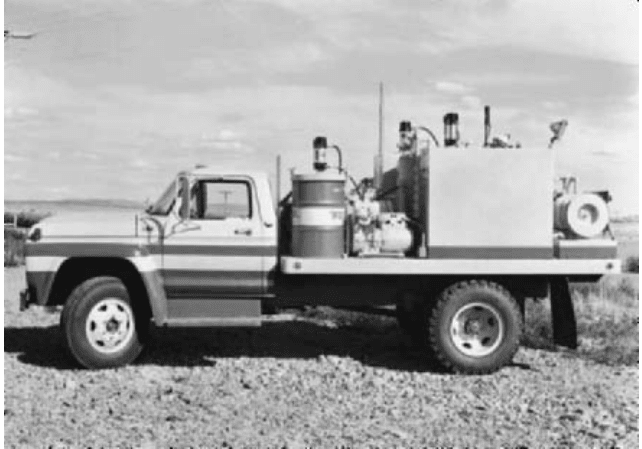
9.20 PORTABLE TRANSFER OF HAZARDOUS LIQUIDS 9.445
FIGURE 3 Flatbed service truck (Aro Fluid Products)
the tanks to hold and transport only clean water is to inject the chemical into the dis-
charge only at time of use. The chemical is kept in small, 1 to 5 gallon (3.5 to 20 liter) con-
tainers with 12-volt metering pumps attached, which allow direct injection into the clean
water line. Other systems use small proportioning pumps. These units are two-stage pis-
ton pumps powered by clean water. The smaller piston injects a set volume of chemical
into the water supply for each stroke of the larger water piston.

SATORU SHIKASHO
9.447
SECTION 9.21
WATER PRESSURE
BOOSTER SYSTEMS
TYPES OF WATER PRESSURE BOOSTER SYSTEMS _______________________
Plumbing fixtures and equipment connected to a water source will function properly only
when a minimum water supply pressure is consistently available. Whenever this mini-
mum pressure cannot be maintained by the supply source, a means of boosting the water
pressure should be considered.
The commonly used methods for boosting pressure are
1. Elevated gravity (tank) systems
2. Hydropneumatic tank systems
3. Variable-speed-drive centrifugal pump booster systems
4. Tankless constant-speed multiple centrifugal pump systems
5. Limited-storage, constant-speed multiple centrifugal pump systems
Table 1 identifies the significant advantages and disadvantages of each system.
Although gravity and hydropneumatic tank systems have some distinct advantages,
most installations favor constant-speed multiple-pump and variable-speed-drive systems.
Because gravity and hydropneumatic tank systems are now seldom specified, they will not
be discussed in detail here. Multiple-pump systems are well suited for high-rise buildings,
apartment buildings, schools, and commercial installations. Variable-speed-drive systems
are particularly suited for industrial applications, where control precision is required and
maintenance capability for complex electronic apparatus is present.
It is important to remember that the primary function of a pressure booster pump for
a building, whether variable- or constant-speed, is to maintain the desired system pres-
sure over the entire design flow range. It is also important to recognize that the cold water
service piping configuration is an open-loop system, not a closed-loop system as it is in
